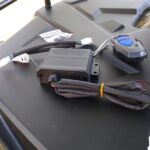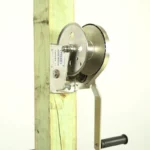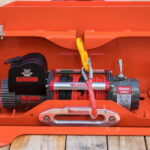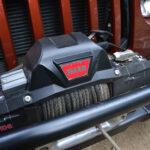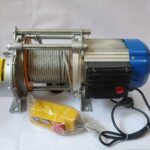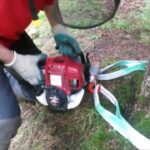Are you a big fan of off-road driving? Well, then, you must be aware of the winches. Often, during adventures, when your vehicle gets stuck at certain wetlands, mudholes and the like, you need a winch to pull it back on track. There are different ways of using a winch, and winching backwards further has three ways.
3 Different ways to winch backwards
We have done thorough research and also talked to winch manufacturers before curating the information we are sharing here. Follow the discussion below to learn about the three ways to winch backwards.
Direct winching
Tools needed
First, let us look into what tools you need for winching backwards in the method of direct winching. The following list will offer you the name of the tools you need for this method.
- Three shackles with D-rings[1]
- Three snatch blocks. Although you might find it relatively uncommon to carry three snatch blocks, it is the safest option.
- three tow straps that are tree savers
- Gloves made of leather
- Cable
- A mat made of rubber or, you can use anything heavy on which you can lay a winch line over
Procedure
Step 1: Look for a stable point for anchoring
Find a point which is strong enough to handle the weight of your vehicle and make it your anchoring point.
Step 2: Release the lever to release the cable further
You will find the disengage lever outside the winch. Identify the labels “disengage” and “free spool”. Turn to the option of “disengage”, which will enable you to pull the winch cable manually.
Step 3: Pull the winch cable out
Ensure to pull the winch cable appropriately and with optimum effort and length; otherwise, it might lead to unnecessary slack.
Step 4: Run the cable beneath the car
Now, run the winch cable under your vehicle. Here you must ensure that it is devoid of any places that can potentially cause damage to the cable.
Step 5: Turn the lever.
You will also find the option “engage”. Turn the lever to “engage” now. It will stop any more winch cables from coming out.
Step 6: Winch the car towards the point where you have anchored
Now, use the remote control to winch backwards towards the point of choring that you have chosen earlier in the first step. This causes the winch cable to be pulled towards the winch gradually, and the winch cable will tighten.
Using Snatch Blocks
Tools needed
The following list will offer you the name of the tools needed.
- Three shackles with D-rings
- Three snatch blocks. Although you might find it relatively uncommon to carry three snatch blocks, it is the safest option.
- three tow straps that are tree savers
- Gloves made of leather
- Cable
- A mat made of rubber or, you can use anything heavy on which you can lay a winch line over
Procedure
Step 1: Locate three points to anchor
Find three such points which will be able to handle the weight of your vehicle. And make them your three anchoring points.
Step 2: Release the lever to release the cable further
You will find the disengage lever outside the winch. Identify the labels “disengage” and “free spool”. Turn to the option of “disengage”, which will enable you to pull the winch cable manually.
Step 3: Pull the winch cable out
Ensure to pull the winch cable appropriately and with optimum effort and length; otherwise, it might lead to unnecessary slack.
Step 4: Use the tree trunk protector to wrap around the anchoring points
A nylon strap is a tree trunk protector with a loop at each end. Ensure that the three anchoring points have tree trunk protectors. They would serve the function of holding the snatch blocks.
Step 5: Attach D-shackle
Now attach the D-shackle to the three straps.
Step 6: Attach two snatch blocks to D-shackle
Attach the two catch blocks to the D-shackle except for the last anchoring point.
Step 7: Attach a snatch block to the back of your vehicle
The third snatch block must be attached to the car’s rear part. Locate a safe place to hook the snatch block[2].
Step 8: Use the winch cable to wrap the snatch blocks
Use the winch cable to wrap around the three pulleys and then close the casing.
Step 9: Attach the winch cable hook with the thirds anchoring point
Now, find the winch cable hook and attach it to the third anchoring point.
Step 10: Turn the lever to “Engage”
Turn the lever to the option “Engager”. You will readily find this option on the lever. It will disable any more winch cables from coming out.
Step 11: Start using the winch to pull.
Now start driving backwards as you will now begin to winch your car.
Add another winch to the rear of the vehicle.
Step 1: Find a firm anchoring point.
Find a point which is strong enough to handle the weight of your car. Make that your anchoring point.
Step 2: Attach the winch cable to the rear end of your car
Now, use the winch cable hook to secure it safely to the back of our car.
Step 3: Start pulling the winch cable.
Now, start pulling the winch cable. Ensure that you do so ideally considering the different aspects, such as the weight of the vehicle, length of the cable and the like. Otherwise, the process of pulling the back out might not be quite successful.
Summary
Now you are well aware of the three different methods in which you can use a winch to pull your vehicle backwards. We have discussed the tools that you would require in these methods. Remember to follow the steps serially as they have been presented in the above discussion. So, with that, you can now perfectly go for amazingly adventurous off-road trips without any worries.
References
-
Digital, P. (2021, March 16). How to use a D shackle correctly – by Ropes Direct. Ropes Direct. https://www.ropesdirect.co.uk/blog/how-to-use-a-d-shackle-correctly/#:~:text=D%20shackles%20are%20used%20every,how%20to%20handle%20them%20correctly.
-
TJM. (n.d.-b). How snatch blocks work and how to use them. https://www.tjm.com.au/blog/how-snatch-blocks-work-and-how-to-use-them
More on Winch


